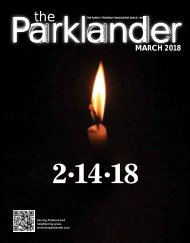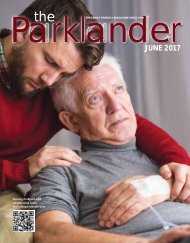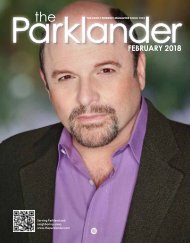May 2018
Create successful ePaper yourself
Turn your PDF publications into a flip-book with our unique Google optimized e-Paper software.
FIRST RESPONDERS<br />
Marjory Stoneman Douglas First Responders:<br />
HEROES Every Step of the Way<br />
by Beatrice Levine<br />
Often times we hear of tragic events after they happen. Here is<br />
how they begin.<br />
It all starts with dispatch, “the calm voice in the storm.”<br />
DISPATCH<br />
Gunshots echoed in the dispatch room. Kathy Liriano picked<br />
up the phone: “Help! There is a man with a gun shooting at kids<br />
at MSD high school!” It was from a teacher who had students<br />
in her room that were injured from gunshots that were fired<br />
through the window and door of her classroom. As Liriano<br />
heard gunshots through the phone, she remained strong while<br />
attempting to calm the caller. She assured her that help was<br />
on the way and told her, “as long as I can hear you breathe, I<br />
know you are there, so it’s OK. I’m here.” Liriano is the head<br />
supervisor for the dispatch call center at the Coral Springs<br />
Police Department. She jumped on a call in order to help with<br />
the more than 1,000 calls that came flooding in on February 14.<br />
Since all 911 cell phone calls made from Parkland are directly<br />
routed to the Coral Springs Police Department, the dispatch call<br />
center had quite the task in front of them.<br />
“911 dispatchers actually are our first responders,” Liriano said.<br />
They document all pertinent information from callers and relay<br />
that information to the officers being dispatched. They gather as<br />
much information as they can, while calming callers at the same<br />
time. First responders rely on this information in order to prevent<br />
them from entering blindly into a situation. Dispatchers are often<br />
referred to as the “ears before the eyes get there.”<br />
POLICE<br />
Sergeant Carla Kmiotek, head of training for the Coral Springs<br />
Police Department, was in a meeting that day when an officer<br />
charged in and proclaimed, “There’s an active shooter at<br />
Stoneman Douglas!” Sergeant Kmiotek remembers jumping up,<br />
running to her vehicle, opening the door, putting on her bullet<br />
proof vest, removing her rifle from the top of her car, loading<br />
it, and speeding over to the “north side of the building” at<br />
Stoneman Douglas High School.<br />
Kmiotek, who has a teenager herself in high school, charged<br />
into the 1200 building. She immediately encountered the<br />
carnage. Her first thought was, “This is bad, this is really bad.”<br />
Children were strewn everywhere. Some dead. Some badly<br />
injured.<br />
There’s an active shooter? What do you do first? Help those<br />
in need that might lose their lives or do you go after the active<br />
shooter? First responders face the challenge of saving lives<br />
or apprehending a violent killer. The challenge is real and<br />
Valentine’s Day <strong>2018</strong> proved that to be the case.<br />
A total of 30 first responders from the Coral Springs Police<br />
Department were on scene that day. The main objective of the<br />
first wave was to find the suspect. Sergeant Kmiotek was in<br />
that first wave. The second wave of first responders entered the<br />
building immediately and attended to the injured. They scoured<br />
the building, performing triage on victims using tourniquets,<br />
combat gauze, chest seals, and trauma dressings, which they<br />
carry on their persons.<br />
FIRE RESCUE<br />
Michael Moser, Division Chief for the Coral Springs Fire<br />
Department, was the first to arrive on the scene, making him<br />
the Incident Post Commander. He informed dispatch where<br />
he set up the medical treatment area. Dispatch then relayed<br />
that information to the police officers so they knew where to<br />
bring the injured victims. Upon arrival to the post, Commander<br />
Moser decided which victims needed immediate hospital<br />
transportation. He was in charge of managing the injured.<br />
Further triage techniques were performed at his command post.<br />
This enabled him to keep victims alive and ensure that they<br />
received urgent care. He orchestrated the coming and going<br />
of emergency vehicles and decided what hospital each victim<br />
would go to.<br />
While interviewing Chief Moser in his office he was multi tasking.<br />
He simultaneously kept an eye on his computer while answering<br />
questions. He was working diligently to arrange public safety<br />
for the March in Parkland. Some events occur without prior<br />
knowledge and some events are planned in advance. When<br />
massive amounts of people will be in attendance, there is an<br />
increased need for police and fire department presence to keep<br />
the public safe and to avoid chaos.<br />
Although all these first responder units, from Dispatch to Police<br />
and Fire Rescue, trained extensively for this type of event,<br />
nothing can ever really prepare them for the reality of an active<br />
shooter. Kathy Liriano, Sergeant Carla Kmiotek, and Division<br />
Chief Michael Moser are just three that are mentioned here,<br />
but all those that give of themselves for others are truly heroes.<br />
Most people don’t know of the efforts these true unsung heroes<br />
made on that fateful day. Fourteen victims were saved. Many<br />
more could have died if not for the quick and coordinated<br />
efforts of all the first responders.<br />
First responders, from the beginning of a tragic event to the<br />
end, are our true unsung American heroes. P<br />
18<br />
MAY <strong>2018</strong>

















